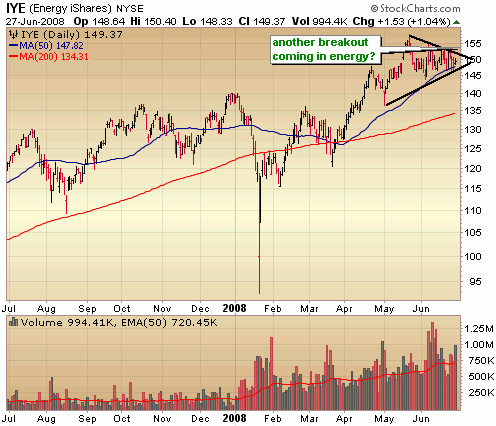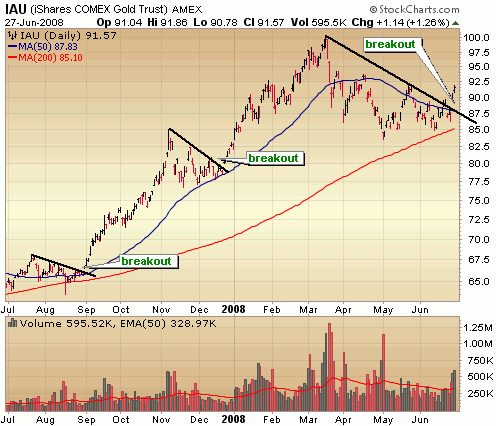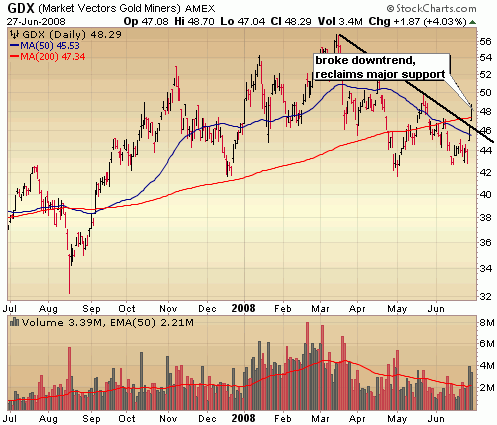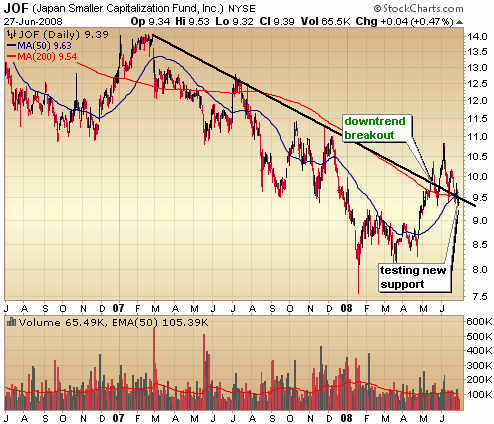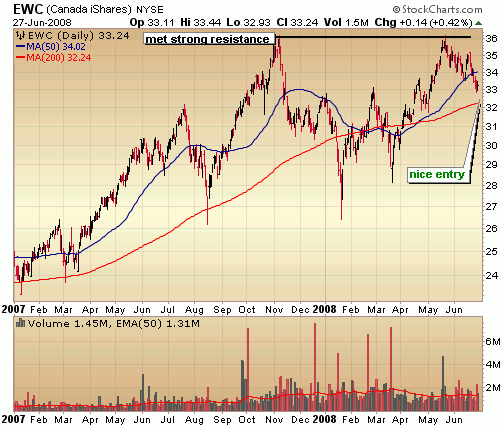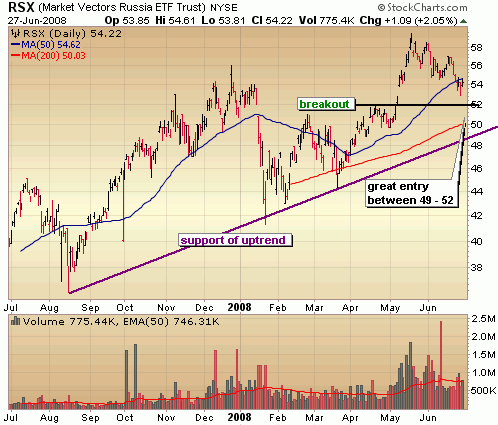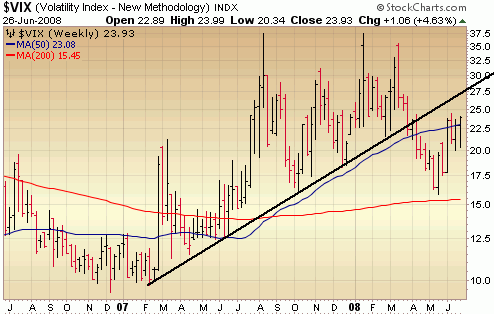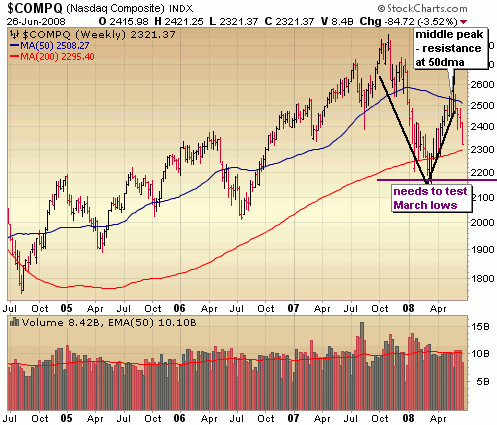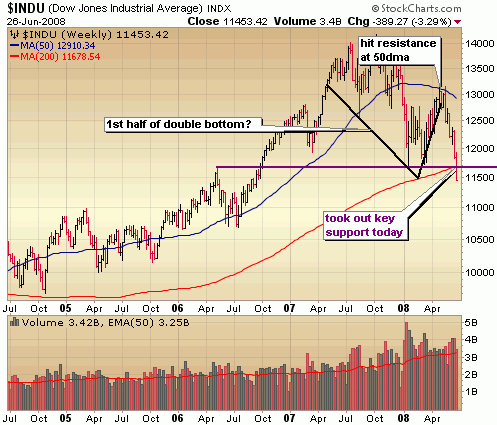What a week, what a Friday.. but we’ve been down this road before. The constant parade of CEOs and government officials denying there are problems. The rumors, the manipulation the itchy trigger fingers of traders. We saw it around the March bottom and one can only hope that we are near the end here at the developing July bottom. I for one am sick of the irresponsibility of the media in disseminating false information and/or rumors in financial news, but hey anything for a headline right? It started with the morning headlines that Freddie and Fannie may be bailed out by the government which provided the catalyst for a sustained sell off, but buyers stepped in big after a report from Reuters that Bernanke had provided Freddie and Fannie with access to the discount window (which they later backed down from after the Fed denied such discussions). As the news drifted to unsubstantiated rumor, much of the gain evaporated, dashing hopes for capitulation.
Fed spokeswoman Michelle Smith said U.S. central bank officials were following the situation with struggling Fannie Mae and Freddie Mac closely but disputed that access to the discount window had been offered. "Federal Reserve officials are following the situation closely. However, there has been no discussion with the GSEs about access to the discount window," Smith said in a statement issued on Friday afternoon.
Friday was so darn close to what you could call an important capitulation day, but panic never quite kicked in. The VIX did come quite close to hitting 30, but the selling was quite orderly throughout. I really wanted to see a 400 – 500 point move down in the Dow to really flush it out, followed by the kind of buying we saw after the Fed rumor from Reuters. Friday was a case of both panic selling and institutional buying fizzling out, leaving the market vulnerable to more losses in the short term (perhaps another few percentage points). However, I do think we are quite close to an intermediate bottom as both the Dow and S&P approach the bottom of their downtrends while the Nasdaq is within shouting distance of the March lows as you’ll see in the charts below.
In the weekly charts of the indices below, the well defined downtrends stand out.. as does the precipitous drop over the past several weeks which is in line with what happened in January. In the Nasdaq, there is quite a bit of room to run before hitting the bottom of the downtrend, but it does have big support at the March lows just below 2200, so it could certainly hold there and never touch the bottom of the channel again. So keep an eye out for capitulation in the Nasdaq in the 2175 to 2200 range.
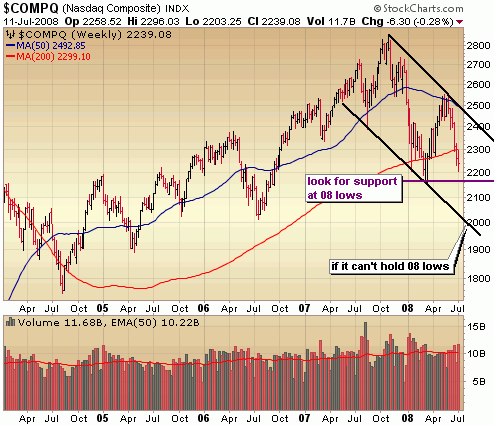
Both the S&P and Dow have taken out the 2008 lows back in March and that really set them up to test the bottom of their downward trends. I do think we will get a furious rally if and when the S&P touches that channel around 1200. So, we’re not quite out of the woods and there is quite a bit of risk of more deterioration, but we’re close. Hang in there.

A similar situation in the Dow as it too approaches the bottom of the downtrend with a nearly vertical drop over the past several weeks. This dramatic move down will not be sustainable for too much longer and it’s just a matter of time before a short covering fueled snap back rally occurs. It could happen very soon. If the Dow takes out 11,000 again, keep an eye on the area around 10700.

I want to leave you this week with market summary from Don Worden of Telechart. The man has a way with words and I particularly liked how he summed up Friday’s action (reprinted with permission):
The market opened in a mood that Alan Greenspan might have described as "irrational despondency." At the outset there seemed to be a widespread preoccupation with the delusion that FANNIE MAE and FREDDIE MAC were heading straight for the bankruptcy pits. You don’t need to be an expert to realize that this is an unthinkable scenario (that could create a calamity greater than the great depression) and that the government would take over those two enormous businesses before they would entertain any idea of letting them go under–should it ever become necessary.
It didn’t help a bit when Treasury Secretary Paulson stated that "no bailout of FANNIE MAE and FREDDIE MAC is on the horizon." Things got worse when somebody spread a rumor that Israel was setting up an air base in Iraq, in preparation for attacking Iran. This was denied promptly and vehemently by American officials, but nobody seemed to believe them. Not for several hours anyway. Oil responded predictably to this chaotic scene, but it was the stock market that was bombarded most cruelly in this fusillade of frivolous nonsense.
It seemed there would be no end to it. The world would simply end in one final conflagration. But then suddenly in the afternoon a Reuters source indicated that FANNIE and FREDDIE would have access to the Fed’s discount window. Stocks responded as if rising from the dead. The Dow rose from down 200 to an actual gain. The assurance that capital would be available to the two lenders if they were in dire need softened concern. The stocks rose.
However, wouldn’t you know that a mob scene doesn’t evaporate that easily. The Fed refused to confirm it would lend to Fannie or Freddie. Stocks simply turned around and went back down. But in contrast to the scuttlebutt that followed, they didn’t go all the way back down. At the close both the Dow and SP-500 had regained close to half of their earlier losses. The Nasdaq Composite had actually regained 76% of it losses.
The day was not a bust. Two of the Eight Important Averages ended in the black. Only three of the eight closed down over one percent despite the earlier havoc. Nothing closed down two or more percent. Despite the seemingly irreparable devastation earlier, three Breadth Groupings held positive scores.
::: Model Portfolio :::
** This section will now appear as a separate report about every other Wednesday.
The Self Investors Model Portolio wrapped up 2006 with a gain of 27.6%, 2007 with a gain of 30.2% and is more than 10% ahead of the S&P in a very difficult 2008. This is a REAL portfolio with position sizing and features annualized returns of 24%.
Would you like to receive buy and sell alerts in the Model Portfolio within minutes (NEW! now get them via instant messaging in near real time) of each transaction? You can receive these along with ALL of the tracking tools and video reports with the very popular Gold membership. Don’t delay, get started today and join me for many more highly profitable months here at SelfInvestors.com.
::: Best/Worst Performers :::
– Top 10 Performing Industries For the Week –
1. Diagnostic Substances: 6.70%
2. Aluminum: 6.30%
3. Drug Related Products: 5.70%
4. Silver: 5.05%
5. Home Health Care: 4.50%
6. Chemicals – Major Diversified: 4.50%
7. Cigarettes: 4.15%
8. Agricultural Chemicals: 4.00%
9. Food Wholesale: 3.70%
10. Metal Fabrication: 3.65%
– Top 10 Worst Performing Industries For the Week –
1. Mortgage Investment: -31.50%
2. Toy & Hobby Stores: -12.00%
3. Specialty Retail: -11.75%
4. Resorts & Casinos: -10.80%
5. Lodging: -10.30%
6. Apparel Clothing: -10.15%
7. Banks – SE: -10.05%
8. Office Supplies: -9.70%
9. Investment Brokerage – National: -9.40%
10. REIT – Hotel/Motel: -8.30%
– Top 5 Best Performing ETFs For the Week –
1. Market Vectors Coal (KOL) 7.95%
2. Claymore China Real Estate (TAO) 7.50%
3. Morgan Stanley China (CAF) 6.53%
4. iShares China (FXI) 5.90%
5. SPDR China (GXC) 5.20%
– Worst 5 Performing ETF’s –
1. US Natural Gas (UNG) -12.20%
2. iShares Broker Dealers -8.35%
3. Dow Jones Home Construction -8.05%
4. SPDR Homebuilders (XHB) -7.90%
5. SPDR Financials (XLF) -6.50%
::: Upcoming Economic Reports (7/14/2008- 7/18/2008) :::
Monday: None
Tuesday: PPI, Retail Sales, Business Inventories
Wednesday: CPI, Capacity Utilization, Industrial Production, FOMC Minutes, Crude Inventories
Thursday: Housing/Building Permits, Initial Claims
Friday: None
::: Earnings I’m Watching This Week :::
Monday: Genentech (DNA)
Tuesday: CoStar Group (CSGP), Intel (INTC), Johnson & Johnson (JNJ)
Wednesday: Ebay (EBAY), Wells Fargo (WFC), Yum Brands (YUM)
Thursday: Danaher (DHR), Evergreen Solar (ESLR), Gilead Sciences (GILD), Google (GOOG), Merrill Lynch (MER), Microsoft (MSFT), SunPower (SPWR), Coca Cola (KO), JP Morgan (JPM)
Friday: Citigroup (C), Schlumberger (SLB)





